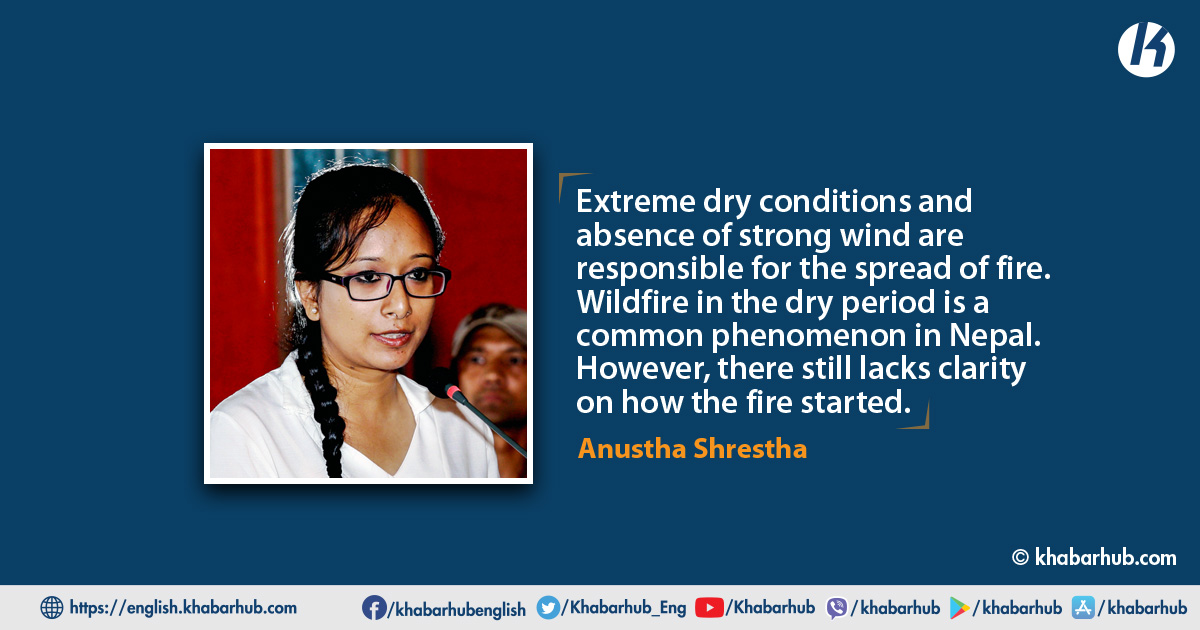On March 26, 2021, a thick smog covered the Kathmandu Valley and reduced visibility.
Most people perceived it as a regular phenomenon and carried on with their lives. However, people who were working or traveling outdoor experienced a “burning eyes” sensation.
Others experienced symptoms such as coughing, sneezing, sore and itchy throat. Later, several experts shared that the air quality index has reached the hazardous level and advised to stay indoors and minimize outdoor activities.
When the air quality index continued to remain at the hazard level, the Government of Nepal decided to close education institutions from March 30-April 2, 2021. That was the first time, Nepal Government had taken such steps to deal with air pollution in the Valley.
One of the primary reasons for air pollution was the forest fires that have been spreading all over Nepal. Extreme dry conditions and the absence of rainfall are responsible for the spread of fire.
Wildfire in the dry period is a common phenomenon in Nepal. However, there still lacks clarity on how the fire started.
There is the practice of burning dry leaves and shrubs in the forest to allow the germination of new grass. Such burning will help to provide fodder for cattle as well as a natural fertilizer.
Some groups are more vulnerable than other populations. Children, pregnant women, the elderly, and individuals with pre-existing heart and lung disease are comparably more vulnerable.
People also burn stems of old crops to make the land ready for farming. We do not know exactly if they were the main causes behind forest fires.
Another reason could be discarding cigarettes near the forest vicinity. In previous years, pre-monsoon rainfall was used to put out the fire.
Few hours of drizzles on April 1, 2021, reduced a certain amount of air pollutants for a couple of days. Yet, it was insufficient to stop the forest fire.
Nepal Disaster Risk Reduction and Management Authority (NDRRMA) has shared that between November 2020 to March 2021, there have been incidences of 2713 forest fires affecting 73 districts in the country.
This is the highest recorded fire incidents since 2012 and 14 times more than the incidents of November 2019-March, 2020.
These fires have also caused unexplainable loss of plant and animal biodiversity and affected the livelihood of community people.
Forest fire releases pollutants such as carbon monoxide, carbon dioxide, nitrogen dioxide, methane, ozone, photo-chemically reactive compounds, and fine and coarse particulate matter.
Carbon dioxide, methane, and ozone also fall under the category of greenhouse gases that are likely to exacerbate climate change.
Conversely, we can also speculate that the current wildfire and dry conditions could be related to climate change. However, we need to have more comprehensive research on this subject.
Air pollutants on the other hand pose major health risks that could seriously affect a larger population. Around 7 million deaths globally are attributed to air pollution.
According to the State of Global Air (2020), in Nepal 42,100 deaths were attributed to air pollution in 2019. Different diseases ranging from asthma to cancer, pulmonary illnesses, and heart disease have their roots related to air pollution.
In the larger picture, the government can partner with private sectors to promote cleaner brick kilns and create enabling environment for electric vehicle users.
Some groups are more vulnerable than other populations. Children, pregnant women, the elderly, and individuals with pre-existing heart and lung disease are comparably more vulnerable.
People with low socio-economic conditions who are facing underlying health problems, poor nutrition, and stress are also vulnerable.
US researchers have suggested that the COVID-19 outbreak may have worsened due to polluted air. European Public Health Alliance has also pointed that air pollution will weaken the immune system and reduce an individual’s ability to combat infection.
Besides forest fire, we need to address other significant sources of air pollution in the Kathmandu Valley. Vehicles are one of the major sources.
In the fiscal year 2074/75, 3.23 million vehicles were registered in Nepal. Among them, 1.17 million vehicles were registered in the Bagmati Zone.
Among the registered vehicles in the Bagmati Zone, 97 percent were private. In addition to air pollution, these vehicles are responsible for massive traffic congestions.
Likewise, construction activities, brick kilns, food and garment industries (operated by coal, wood, diesel), improper waste burning especially plastics further contribute to air pollution.
Additionally, the bowl-shaped structure of the Valley often restricts air movement and pollutants stay in the atmosphere for an elongated time.
Tackling air pollution
Combatting air pollution in the present context comes together with controlling forest fires and protecting biodiversity.
Nepal has Forest Fire Management Strategy (2010) and Kathmandu Valley Air Quality Management Action Plan (2020).
Investing in quality infrastructures such as well-maintained roads for decreasing road dust and making the city cycle-friendly could be other encouraging steps for combatting long-term air pollution.
That means we already have a base to start the work without losing our time. It is time to bring together the previously recognized stakeholders and institutions and implement those strategies and action plans.
The first step could be educating and empowering the local communities to help them tackle emergencies with the help of government, non-government organizations, CSOs, private sectors, and funders. In both cases, stronger penalties for the illegal fire starters and polluters could be effective.
Thus, local-level policies and regulations need to be strengthened. Another step could be a change in our life choices.
For example use of cleaner fuel for cooking (example: induction stove), lessening the use of private transport or practicing walking or carpooling, controlling household/commercial waste and waste burning practices are some of the options.
In the larger picture, the government can partner with private sectors to promote cleaner brick kilns and create enabling environment for electric vehicle users.
Investing in quality infrastructures such as well-maintained roads for decreasing road dust and making the city cycle-friendly could be other encouraging steps for combatting long-term air pollution.
What is necessary at the moment is the organized plan, preparedness, and successful implementation and for that sincere commitment of all the actors and institutions is necessary.
(The writer is a Researcher at the Institute for Social and Environmental Transition-Nepal (ISET-Nepal)









Comment